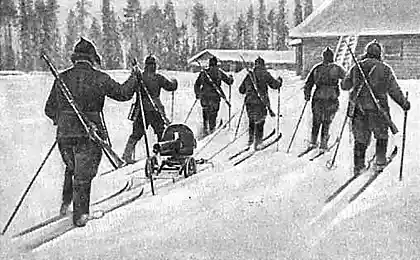414
Vindolanda reveal unknown details about Roman life
In Vindolanda, the famous Roman Fort in Britain, archaeologists have uncovered a wooden toilet seat. It is the only such product that has been preserved from ancient times.
Thirteen million seven hundred forty eight thousand six hundred fifty eight
The wooden seat of Vindolanda in the discovery place.
"We are very excited about this discovery. The seat has survived because of its fantastic preserving conditions on the monument," – said the head of excavations Dr. Andrew Birley (Andrew Birley).
The seat was found in the trench in layers preceding the time of the Emperor Hadrian (reign: 117-138 ad.). Previously known seats of stone and marble, but the product of Vindolanda wood, the only copy of this material, preserved to our days. According to Dr. Birley, the choice of material is due to the region – on the Northern outskirts of the Empire, a wooden seat rather than stone.
"It [seat — Ed.] made of very well crafted piece of wood and looks pretty comfortable," said Dr. Berley.
Forty eight million one hundred seven thousand one hundred sixty three
The wooden seat of Vindolanda.The wooden seat of Vindolanda it served its purpose and was thrown in a landfill located outside of the Fort. This happened before the construction of Hadrian's wall, begun in the second century of our era.
On the preservation of the findings will take approximately 18 months, after that seat will be on view in the Museum.
"It's really exciting when you find something that no one has ever seen before. We know many Roman toilets from the excavations of previous years, with this monument, and more – from other regions of the Roman world, among them is the famous Roman latrines, but never before have we had the pleasure of seeing a surviving and perfectly preserved wooden seat," said the head of the excavation. According to him, as soon as archaeologists began to clear the find they had no doubt what they found.
He added that now the archaeologists hope to find the toilet, which is the seat since the Roman latrines – is a fun place to dig. In the sewers often find amazing things. "Let's face it, if you drop something in the Roman latrine, you will hardly attempt to catch it, unless you are very brave or foolhardy," – said the head of the expedition.
Archaeologists also cherish the hope that sooner or later they will be able to find also and bath sponge (spongia) the Romans fastened on a stick and used it instead of toilet paper. In the unique conditions Vindolanda such a find is quite likely.
Vindolanda is one of the most famous Roman monuments in Europe. This Roman Fort was part of the fortifications of Hadrian's wall, which protected Roman Britain from the barbarians.
Due to the unique natural conditions (marshy soil) is well preserved organic materials – leather, fabric, wood. The monument became famous after the discovery of wooden tablets on which inscriptions are made with coal ink.
Archive of Vindolanda is a collection of various official documents and private letters. Most of these documents Dating to I-II centuries ad. Among the tablets preserved correspondence of the Roman commanders, reports, lists of provisions, of various things. Among the found documents – letter from Claudia Severa, wife of Elia Brochu, who commanded nearby Fort. In the letter Claudius invites for the birthday of his girlfriend Sulpizio Lepidine, the wife of the Roman commander of Vindolanda. This document is one of the oldest written by a woman.
Some signs included quotes from literary works. Thanks to other tablets the researchers significantly expanded their ideas about the Roman geography of Britain: in which are mentioned many names of Roman fortifications and settlements. Signs of Vindolanda also a lot of talk about literacy in the Roman army, Latin language and palaeography, about the life of Roman soldiers. Some of these unique documents are exhibited in the British Museum.
Hadrian's wall – a fortification with a length of about 120 kilometers. It was built in 122-126 years BC the fortress was protected from the North the territory of Roman Britain from the raids of barbarian tribes.
Source: nkj.ru
Thirteen million seven hundred forty eight thousand six hundred fifty eight
The wooden seat of Vindolanda in the discovery place.
"We are very excited about this discovery. The seat has survived because of its fantastic preserving conditions on the monument," – said the head of excavations Dr. Andrew Birley (Andrew Birley).
The seat was found in the trench in layers preceding the time of the Emperor Hadrian (reign: 117-138 ad.). Previously known seats of stone and marble, but the product of Vindolanda wood, the only copy of this material, preserved to our days. According to Dr. Birley, the choice of material is due to the region – on the Northern outskirts of the Empire, a wooden seat rather than stone.
"It [seat — Ed.] made of very well crafted piece of wood and looks pretty comfortable," said Dr. Berley.
Forty eight million one hundred seven thousand one hundred sixty three
The wooden seat of Vindolanda.The wooden seat of Vindolanda it served its purpose and was thrown in a landfill located outside of the Fort. This happened before the construction of Hadrian's wall, begun in the second century of our era.
On the preservation of the findings will take approximately 18 months, after that seat will be on view in the Museum.
"It's really exciting when you find something that no one has ever seen before. We know many Roman toilets from the excavations of previous years, with this monument, and more – from other regions of the Roman world, among them is the famous Roman latrines, but never before have we had the pleasure of seeing a surviving and perfectly preserved wooden seat," said the head of the excavation. According to him, as soon as archaeologists began to clear the find they had no doubt what they found.
He added that now the archaeologists hope to find the toilet, which is the seat since the Roman latrines – is a fun place to dig. In the sewers often find amazing things. "Let's face it, if you drop something in the Roman latrine, you will hardly attempt to catch it, unless you are very brave or foolhardy," – said the head of the expedition.
Archaeologists also cherish the hope that sooner or later they will be able to find also and bath sponge (spongia) the Romans fastened on a stick and used it instead of toilet paper. In the unique conditions Vindolanda such a find is quite likely.
Vindolanda is one of the most famous Roman monuments in Europe. This Roman Fort was part of the fortifications of Hadrian's wall, which protected Roman Britain from the barbarians.
Due to the unique natural conditions (marshy soil) is well preserved organic materials – leather, fabric, wood. The monument became famous after the discovery of wooden tablets on which inscriptions are made with coal ink.
Archive of Vindolanda is a collection of various official documents and private letters. Most of these documents Dating to I-II centuries ad. Among the tablets preserved correspondence of the Roman commanders, reports, lists of provisions, of various things. Among the found documents – letter from Claudia Severa, wife of Elia Brochu, who commanded nearby Fort. In the letter Claudius invites for the birthday of his girlfriend Sulpizio Lepidine, the wife of the Roman commander of Vindolanda. This document is one of the oldest written by a woman.
Some signs included quotes from literary works. Thanks to other tablets the researchers significantly expanded their ideas about the Roman geography of Britain: in which are mentioned many names of Roman fortifications and settlements. Signs of Vindolanda also a lot of talk about literacy in the Roman army, Latin language and palaeography, about the life of Roman soldiers. Some of these unique documents are exhibited in the British Museum.
Hadrian's wall – a fortification with a length of about 120 kilometers. It was built in 122-126 years BC the fortress was protected from the North the territory of Roman Britain from the raids of barbarian tribes.
Source: nkj.ru
The fight against waste and saving energy with your hands
First reaction to HIV and inflammatory destruction of the intestine























